
Italeri 1/48 IAI Dagger
| KIT #: | 4703 |
| PRICE: | $30.00 |
| DECALS: | Aerocalcas, spares, and home made |
| REVIEWER: | Pablo Calcaterra |
| NOTES: | Resin nose and bits from Heller kit. |

| HISTORY |
Dagger C-418 started her life as Nesher S-46 and was delivered to the Argentine Air Force on November 16 1978 with 446 flying hours.
She was the Dagger that flew the most missions (11) along with C-421 during the 1982 crisis in the South Atlantic.
When the British forces landed at San Carlos on May 21st the Argentines threw everything at them. As one of the first sections to attack in the first wave during the morning we have the OF (Orden Fragmentaria or Fragmentary/Partial Order) 1182 called PERRO. Led by Capt Moreno, Lt Volponi in C-41 and Mj Martinez they took off from Rio Grande at 9:45. They arrived at San Carlos waters at 10:31 and attacked HMS Antrim with their 500 kg (1,000 lb) bombs. Antrim was at that moment the air defence control ship. A Seaslug had been fired at the Daggers but they were too low to be hit by the missile. After dodging the enemy fire the PERROs where chased by a Sea Harrier PAC from 800 Sqn (Lt Cmdr Fredericksen and Lt Hale). The last shot a Sidewinder out of range and missed. As a result of the attack one of the bombs impacted the ship along with around 40 rounds of their 30 mm guns. The bomb bounced off the flight deck and passed through several compartments (including the Seaslug magazine missing one missile by only 3 feet). The bomb came to rest in one of the ship’s heads and did not explode. The ship Wessex XP-142 was slightly damaged by bomb splinters and several fires broke out in the sip. The bombs had been dropped too low and at too high speed and thus they did not have enough time to get armed. Ten of her crew were injured and the ship so seriously damaged. A bomb defusal team was flown to Antrim and the bomb was lowered into the sea. With her air defense system out of action Antrim left the Sound and was assigned to escort duties in the replenishment area out of the combat zone following essential repairs.
Taking part in the 3rd wave on the same day C-418 was flown
following instructions of OF1193 by Capt Mir Gonzalez leading Lt Bernhardt and
1st Lt Luna as the CUECA. Two more Daggers in the next OF (LIBRA) followed them.
One (Robles) had to return due to an oil leak and then the 4 planes formed
together with CUECA now being Mir and Bernhardt and LIBRA Robles and Luna. They
found their path full of low clouds (less than 150 ft) and decided to fly very
low. HMS Brilliant had seen them in her radar and Lt Cr Federiksen and S.Lt
George were vectored to the Daggers. The planes were flying in a single line and
Fredericksen wanted to shot down one after the other starting by the last one.
Luna saw his 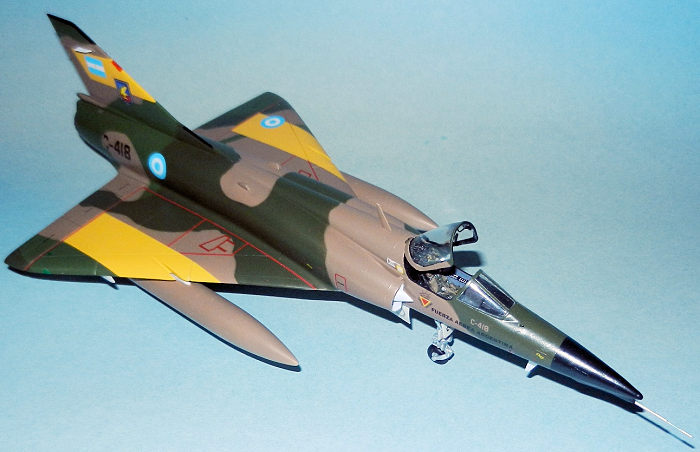 attacker
but was unable to dodge the Sidewinder or alert his colleagues due to a problem
with his radio. His plane was hit and he ejected safely being recovered by the
Argentines later on. But then the PAC was in the defense range of the ships and
the Harrier pilots were told to break the attack. Thus the 3 other Daggers had a
clean run against the ships. The Daggers attacked with their bombs and guns HMS
Ardent that had just been attacked by Capt Carballo single handy in his A4-B.
Bernhart’s bomb hit the hangar and exploded destroying Lynx XZ-244. Another bomb
(this one did not explode) also hit the ship. Leaving their target badly damaged
and on fire the Daggers returned safely to their base after dodging some
missiles fired by the British. While she was trying to reach the protection of
the rest of the ships to the north Ardent was found and sunk by two waves of
Argentine Navy Skyhawks that impacted her with SnakeEye bombs multiple times.
Breaking in two she sunk in a very short period of time.
attacker
but was unable to dodge the Sidewinder or alert his colleagues due to a problem
with his radio. His plane was hit and he ejected safely being recovered by the
Argentines later on. But then the PAC was in the defense range of the ships and
the Harrier pilots were told to break the attack. Thus the 3 other Daggers had a
clean run against the ships. The Daggers attacked with their bombs and guns HMS
Ardent that had just been attacked by Capt Carballo single handy in his A4-B.
Bernhart’s bomb hit the hangar and exploded destroying Lynx XZ-244. Another bomb
(this one did not explode) also hit the ship. Leaving their target badly damaged
and on fire the Daggers returned safely to their base after dodging some
missiles fired by the British. While she was trying to reach the protection of
the rest of the ships to the north Ardent was found and sunk by two waves of
Argentine Navy Skyhawks that impacted her with SnakeEye bombs multiple times.
Breaking in two she sunk in a very short period of time.
On the 23rd very early in the morning C-418 was flown by 1st Lt Ratti along with Capt Cimatti and Rhode (OF1205 PUMA). They were not able to link with their Learjet that was going to lead them to the target area and thus returned to their base with bad weather. In the afternoon DAGA (OF1214) tried to reach the Task Force again. Ratti again was #2 in C-418 with Cimatti and Rhode. Cimatti was forced to return with a fuel leak. Their target was north of San Carlos water. They did not find it (remember Daggers had no radar) and so informed their Air Controller. DAGA 1 contacted the next section (PUÑAL) and heard PUÑAL 2 calling a warning to his leader as they were under attack by a PAC. Hale shot down Lt Volponi and the Dagger fell on Pebble Island. PUÑAL 1, flying slightly head and faster was able to escape the Harriers.
The following day the attacks resumed but this time they were planned in a way that the planes would come in from the east and not the west like they had been doing in the previous days. In the morning several sections were sent to attack the landing ships in Port San Carlos (not in the sound as now the Argentines had a better idea of where the landing was taking place). OF1225 had four Daggers (AZUL) with Capt Mir Gonazalz, Lt Bernhardt, Capt Maffeis and Robles (in C-418). They took off from Rio Grande at 10 in the morning and they attacked RFA Sir Bedivere whilst anchored in San Carlos Water. They faced the now established defenses in the area so not only they were facing the fire from the ships but also ground troops and Rapier batteries. The ship was hit by an Argentinian bomb which cut through her crane’s steel plating and then bounced into the sea before exploding and caused minor damage. When the Daggers were returning over San Carlos Sound (Estrecho) they were chased by an unidentified Harrier PAC that fired their guns but missed the last two Daggers. Bernhardt and Maffeis planes received some impacts during the attack but all four Daggers returned safely.
On Argentina’s National Day (May 25) C-418 was flown by Capt Rhode as part of OF1233 RANGO (Rhode, Jannet) and OF1234 BINGO (Cimatti, Moreno).Their target was a supposed British radar in Beaucheme islands, way to the south of East Falkand (Isla Soledad). They were led by Learjet T-23. Having led the attack planes to within a hundred miles of the islands the Learjet finished his mission and left the Daggers to continue. The Daggers did a visual inspection of the area without finding any radar or ships and then they left the area at low height followed by a normal return at high altitude.
On the 28ths POCKER (OF1256) was ordered to attack ships to the south of San Carlos bay. They were Capt Maffeis, 1st Lt Ratti, Mj Martinez and Capt. Janett in C-418. They were led by Learjet T-23 who left them 100 miles away from the target. The weather was terrible over the islands and at the Sound. So bad it was that they were unable to see each other even though they were flying in a very tight formation. When they were 90 seconds away from the target and with no visibility they decided the return individually. They were able to listen in their radio the celebrations of Lt Cimbaro who had shot down a British helicopter in his Pucara. The Daggers landed back in Rio Grande at 1pm. That terrible weather caused the demise of Cimbaro who crashed on a hill in low clouds when he was returning to the airfield.
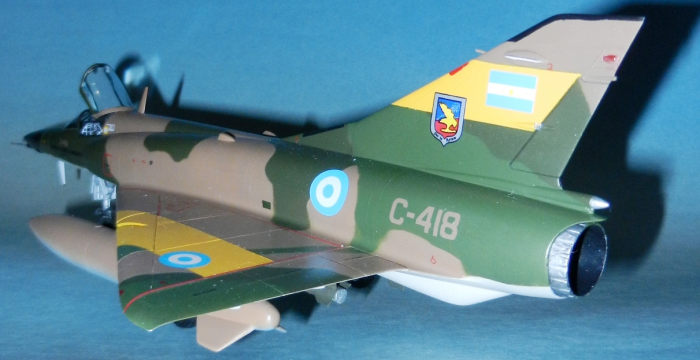 By early
June the Argentines were unable to find valuable targets and they had to fly
offensive reconnaissance missions. One of such was on June 5 when two Daggers
(FIERRO OF 1280) looked for targets to the north of San Carlos Water (Estrecho
San Carlos). Flying at 300 ft in the area and risking being shot down by a
missile from an unseen ship Capt Martinez and Capt Moreno in C-418 searched the
zone without success.
By early
June the Argentines were unable to find valuable targets and they had to fly
offensive reconnaissance missions. One of such was on June 5 when two Daggers
(FIERRO OF 1280) looked for targets to the north of San Carlos Water (Estrecho
San Carlos). Flying at 300 ft in the area and risking being shot down by a
missile from an unseen ship Capt Martinez and Capt Moreno in C-418 searched the
zone without success.
The next mission of this plane during the war was during the Bluff Cove Disaster (Bahia Agradable) or the Darkest Day of the Task Force as it was also called. PERRO (OF1291) was made up of 3 Daggers followed by GATO (OF1292) with 3 more Daggers. GATO 3 had to abort after takeoff when the windshield cracked. C-418 was GATO 2 and was flown by Capt Martinez. They were led to Cape Meredith or Belgrano by Learjet LR-35 T-23. From there the planes now forming in 3 at the front and 2 at the back turned Norwest with the idea to fly north on the Sound and then turn East to get to Bahia Agradable or Bluff Cove. On their way thru the Sound they found HMS Plymouth who, upon seen the Daggers approaching, turned East. Passing on with the ground masking them and leaving the ship behind then the Daggers turned in a South-south-east direction and attacked the ship from the North. They put maximum power and flying at 7 to 9 meters over the waves at roughly 500 knots they commenced the attack trying to reach her from her least protected point (the stern). Everybody on the ship was firing to the planes, even with hand held arms. Apparently they were also receiving fire from the coast. The Daggers fired their 30 mm guns and dropped their 2 x 250 kg (500lb) retarded by parachutes bombs. Four of these hit Plymouth. None exploded but one hit a depth charge that exploded and started a fire. One of the bombs even flew thru one of the chimneys leaving a passing hole from side to side! The ship was heavily damaged and did not take part in the rest of the war. The only damage to the Daggers was small impacts on the external drop tanks. This attack is very well documented not only by the cinegun of the Daggers but also by Spike Rilley of the ship’s crew. For an excellent description of the attack and lots of pictures you can go to https://www.3040100.com.ar/perros-y-gatos-sobre-la-plymouth/
On the 9 C-418 flown by 1st Lt Antonietti and led by Capt Mir Gonzalez along with Mj Martinez looked for a naval target in the Sealions (Leones Marinos) island. They were led by a Learjet but they did not find any target and thus returned to Rio Grande.
Finally, on June 13 the Daggers were ordered to attack ground targets in the Port Harriet area, south of Stanley (Puerto Argentino). The planes were armed with 2 x 250 bombs. VULCANO (OF1324) was led by Capt. Janett in C-418 leading 1st Lt Antonietti and Capt Robles who was unable to take off due to a mechanical problem. They were followed by the ZEUS (OF 1323) with Capt Rhode, 1stl Lt Gabari and Capt Moreno (who suffered an accident boarding his plane and was not able to take part as well). When the fuses of the bombs were being changed as now the attack was going to be at high altitude one NCO Pedro Miranda accidentally triggered the arming sequence of the fuse of one of the bombs in Janett’s plane. Miranda, who had already defused armed bombs two times previously during the war (Carballo’s on ARA Formosa and Zubizareta’s A-4Q), gave the alarm and everybody run away except for him who started to remove the fuse and managed to do that just at the moment when it was about to blow up. For these 3 heroic actions Miranda received the most important Argentine condecoration (Heroico Valor en Combate). With this issue fixed the planes took off but when nearing the target the Argentine radar in Stanley / Puerto Argentino warned them about several Harrier PACs homing on them. Therefore the planes had to abort the attack. The planes returned to Rio Grande with their bombs still on.
And thus the long story of C-418 in the 1982 war finished.
On June 7 1987 C-418 was taking part in an air to air exercise. Capt. Fernando Robledo lost control of the plane and it entered a flat spin. Unable to recover control and having descended to the minimum safety level of 10,000 ft he was forced to eject from the plane that crashed in Cabaña Los Tapiales close to Tandil, home base of the Daggers.
| THE KIT |
 I used the
Dagger/Nesher Italeri kit. This one has the VHF antennas and the Dagger nose.
Regretfully the nose does not have any access panel and the root for the long
probe under the nose is too short. Also note that the decals have a mistake
(FUERA AREA ARGENTINA instead of FUERZA AEREA ARGENTINA). When I received it
there were scratches on the wings and the pitot on the nose was broken and very
graciously and free of charge Italeri sent me a new set of parts to replace the
damaged ones. That being said I am only going to focus on the outstanding
characteristics of C-418 during the war and the work to make the nose of C-418
two years after the war.
I used the
Dagger/Nesher Italeri kit. This one has the VHF antennas and the Dagger nose.
Regretfully the nose does not have any access panel and the root for the long
probe under the nose is too short. Also note that the decals have a mistake
(FUERA AREA ARGENTINA instead of FUERZA AEREA ARGENTINA). When I received it
there were scratches on the wings and the pitot on the nose was broken and very
graciously and free of charge Italeri sent me a new set of parts to replace the
damaged ones. That being said I am only going to focus on the outstanding
characteristics of C-418 during the war and the work to make the nose of C-418
two years after the war.
| CONSTRUCTION |
I wanted to build this particular Dagger with her kill marks…but these were not worn during the war. So I used the Esci/Italeri kit to represent the plane during the June 8 mission to attack HMS Plymouth (very well documented with pictures taken from an Argentine Learjet) and the left over single seat nose from a Heller kit that I still have in the stash (I will later build it as a two seater). This nose represents the same plane but more worn out and with the kill marks as seen on July 9 1984 during the celebrations of the Argentine Independence Day.
a) In regards to the Esci/Italeri kit you can read my previous
reviews. There is nothing different except for the fact that I was able to use
the VHF antennas supplied by Italeri instead of scratchbuilding them.
 With no
panels inscribed on the plastic part of the kit I decided to use one of my resin
copies. The only difference for this particular build is that I have used the
1,700 lt tanks that were supplied by Peru to Argentina during the war (hence the
desert cammo on them). Cammo was applied per the pictures of C-418 that show the
plane returning from the mission to attack HMS Plymouth.
With no
panels inscribed on the plastic part of the kit I decided to use one of my resin
copies. The only difference for this particular build is that I have used the
1,700 lt tanks that were supplied by Peru to Argentina during the war (hence the
desert cammo on them). Cammo was applied per the pictures of C-418 that show the
plane returning from the mission to attack HMS Plymouth.
b) Moving on to the Heller conversion this one was dramatically more complex due to the limited number of parts available for this “conversion”
I started with only a few pieces of the Heller single seat version: the cockpit tub, the 4 parts for the nose, main landing gear bay, air intakes, instrument panel, stick and canopy. I had to scratchbuild the following: nose, seat, windshield, gunsight, landing gear doors, pitot and nose probe, support for the intakes and the main structure from the intakes backwards. The seat was a copy in resin from an aftermarket one; same goes for the Dagger/Nesher nose. The rest was scratchbuilt.
So for starters I cut out the MIII nose at the panel line and erased the air takes supports as these are for the MIIIC version that starts too far forward. Instrument panel and side consoles were painted in black and the floor and side of consoles in dark grey. Then copies of the decals from Esci printed in white decal paper were attached to the instrument panel and side consoles. As the cockpit hub sticks out behind the cockpit walls I took some plastic, cut it long enough to match the end of the new position of the air intakes, bent top and bottom to follow the contour of the cockpit walls and then glued it using some more plastic on the inside to strengthen the union.
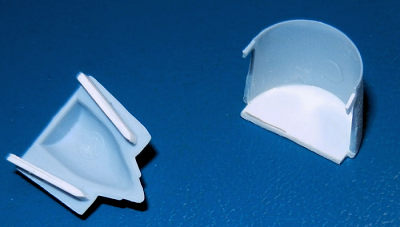 The square
gap where the main fuselage connects to cockpit thru a plug was covered with
plasticard and this and the union of the cockpit extension were improved with
putty and sandpaper. The supports for the air intakes (not as fancy as the
original Heller but practical) were made with triangles of plasticard double
stacked to achieve the needed thickness. Then the cockpit hub was enclosed in
the cockpit walls. The lens for the downward camera (?) under the nose was
covered with more plastic and putty. The resin nose was glued with gel instant
glue. Putty improved all the seams and unions.
The square
gap where the main fuselage connects to cockpit thru a plug was covered with
plasticard and this and the union of the cockpit extension were improved with
putty and sandpaper. The supports for the air intakes (not as fancy as the
original Heller but practical) were made with triangles of plasticard double
stacked to achieve the needed thickness. Then the cockpit hub was enclosed in
the cockpit walls. The lens for the downward camera (?) under the nose was
covered with more plastic and putty. The resin nose was glued with gel instant
glue. Putty improved all the seams and unions.
Then it was the time for the landing gear doors. These are a single piece of plasticard, slightly curved and with the 3 doors made by making 2 slight cuts with an Xacto knife at the proper places. The back of the air intakes was made with semicircular pieces of plasticard and the top and bottom support with strips of the proper length with the front thinned out with sand paper. As the landing gear wheel still stuck out behind the structure I attached some clear thin plastic (from a used binder). My first idea was to leave the back part clear with the paint fading towards the end to represent the speed of the plane in flight but then I discarded this approach deciding to paint it completely.
 The pilot
is from the Monogram Harrier. It is excellent in terms of detail and also the
fact that the helmet is exactly the same type as used by the Dagger pilots. I
painted it with the proper colours including the Grupo 6 badges on the right arm
and helmet (which was then painted with Future). With 2 thin strips of masking
tape I made the seat harness and “attached” it to the seat. I added the stick
and the cockpit was almost ready after I added a scratchbuild gunsight.
The pilot
is from the Monogram Harrier. It is excellent in terms of detail and also the
fact that the helmet is exactly the same type as used by the Dagger pilots. I
painted it with the proper colours including the Grupo 6 badges on the right arm
and helmet (which was then painted with Future). With 2 thin strips of masking
tape I made the seat harness and “attached” it to the seat. I added the stick
and the cockpit was almost ready after I added a scratchbuild gunsight.
Because the Heller kit has 2 canopies (single and two-seater)
but only windshield I had to source another one for this project. I had none in
my spares so I made a copy following these steps: I filled the original
windshield with blue tac, poured a 50/50 water/plaster of Paris mix in an empty
plastic fruit cup container. When the mix was starting to get firm I buried the
windshield to the edge in the mix with the putty facing up. The following day I
removed the windshield very carefully and now I had the shape imprinted in the
plaster of Paris. Then I took two part epoxy (the plumbing type) and carefully
filled the hole in the plaster ensuring I was not scratching the surface. One
more day and I was able to break down the plaster leaving a perfect epoxy plug
with the internal dimensions of the windshield. After cleaning the rest of the
plaster with a brush and water I stuck the plug on a piece of wood using blue
tac. I cut 3 pieces of Squadron thermos formed clear material for canopies and
went to 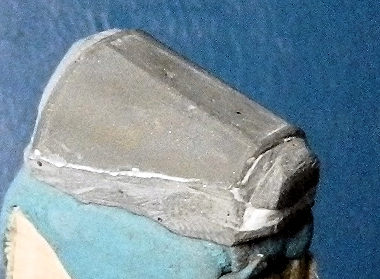 the
shed with a small candle and all the pieces (not to start a fire in the house in
case of an accident!). So sitting in the shed I lit the candle and put the 1st
of the Squadron rectangles over the flame some 10 inches away. Once it started
to get soft I rammed in on top of the plug/wood stick that I was holding with my
knees. Good result. Just in case I repeated it 2 more times allowing the plug to
cool down a bit just in case in between. I ended up with 2 very good copies and
one that was not as good as I had not pulled down the sides firmly enough. A
couple of days later I trimmed one very carefully and dry fit it in place. It
worked great!
the
shed with a small candle and all the pieces (not to start a fire in the house in
case of an accident!). So sitting in the shed I lit the candle and put the 1st
of the Squadron rectangles over the flame some 10 inches away. Once it started
to get soft I rammed in on top of the plug/wood stick that I was holding with my
knees. Good result. Just in case I repeated it 2 more times allowing the plug to
cool down a bit just in case in between. I ended up with 2 very good copies and
one that was not as good as I had not pulled down the sides firmly enough. A
couple of days later I trimmed one very carefully and dry fit it in place. It
worked great!
I added the rear mirrors and a handle to the canopy, masked it and glued it in place. I also masked the windshield and added two small square instruments to the upper frame of the windshield and with lots of care using gel cyano and a bit of Tamiya liquid cement I was able to glue it to the nose. No putty needed!
I cut a wide strip of plasticard, attached it to the back of the construction and this would be part of the stand but also the piece that I grabbed with the pliers of the stand to paint it. In regards to the stand itself…this is a support for a heat gun that I had put aside for any potential use. I covered the base and the vertical side (bent exactly to 90 degrees) with plasticard.
| COLORS & MARKINGS |
Vallejo Black Primer was used for the windshield and canopy frames. Then Light Grey was used as primer. The air intake cones and internal side were painted white. The back end of the intakes was painted in black with a brush.
I used ModelMaster Acrylic paints. First I used Light grey (4766) for all the undersurfaces, followed by Tan (4709), then Medium Green (4734) and finally Dark Green (4726). The demarcation lines between colours are not sharp so I used Blue Tac to obtain the desired effect. Note that there are retouches on the paint done after the war like the top portion of the internal part of the air intake/cone painted in dark green.
The 30 mm guns openings were painted with black. The cockpit
area was masked and the nose was painted black. Some gentle coats of Future left
a nice surface to attach the d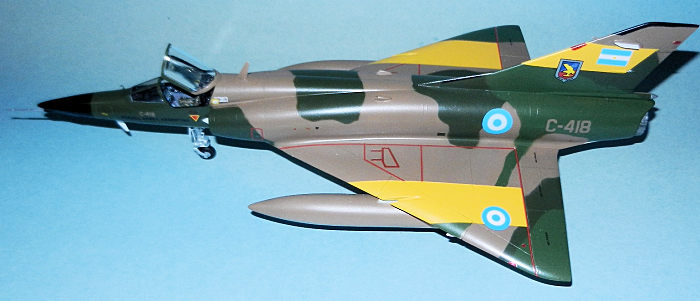 ecals.
The white islands and small stencils came from an Aerocalcas set, same as the
“C-41”. The “8” was made with pieces of “0” and “2” left over from other
Aerocalcas sets of Daggers.
ecals.
The white islands and small stencils came from an Aerocalcas set, same as the
“C-41”. The “8” was made with pieces of “0” and “2” left over from other
Aerocalcas sets of Daggers.
“Fuerza Aerea Argentina”, the words “Peligro Asiento Eyectable” for around the yellow and red warning triangles, the stencils for the emergency release of the canopy were all self-made using clear decal paper. For the kill marks I used the white ones from Aerocalcas but the Union Jacks did not have the white part nor were the yellow halves very accurate. So I scanned these decals and converted the parts I needed to yellow. Then I used a Union Jack from the web, scale it down and pasted in on top of the yellow part of the ships. Then these were printed on clear decal paper and one by one very carefully added on top of the white silhouettes. There are 3 damaged and one full kill (bottom one).
For the base, that I had sprayed with Vallejo Aluminum and covered in Future, I added the badges for the Grupo Técnico 6 and Grupo 6 from Aerocalcas. These have a white edge but it should be aluminum so I cut the white areas out. On clear decal paper I printed the new rim thus achieving an aluminum edge for the badges. Finally I found the proper font for the stencils used in the Argentine Air Force and typed the text for the stand that then was printed on clear decal paper. Needless to say before applying these homemade decals the ink was covered and protected with a gentle coat of Testors Decal spray.
| FINAL BITS |
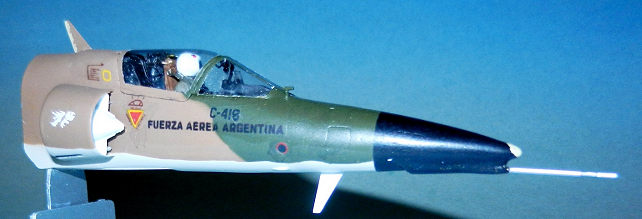 The air
intakes were added. A small couple of black dots surrounded by aluminum applied
with a very thin brush represented the scratches around the locating points of
the access ladder. Finally, a coat of semi gloss clear varnish from AeroMaster
sealed the decals.
The air
intakes were added. A small couple of black dots surrounded by aluminum applied
with a very thin brush represented the scratches around the locating points of
the access ladder. Finally, a coat of semi gloss clear varnish from AeroMaster
sealed the decals.
Scratched tip of the nose was made with a mix of white, beige and yellow. The VHF antennas were added. The masks were removed and the canopy was highlighted with a thin black pencil. The pitot tube was made with parts found in the spares box, as the long probe on the nose.
Finally everything was attached to the base using super glue.
| CONCLUSIONS |
A simple process for the Italeri war time version (it was my 7th and final Esci / Italeri Mirage!!!) and a nice challenging project for the post war nose. With this I have completed my collection of Daggers. There should be the two seater in the future and maybe a IIICJ…but I am done with the wartime deltas.
| REFERENCES |
Dagger and Finger en Argentina (1978-2004) by Claria, Mosquera, Posadas, Cettolo, Gebel, Marino
Official History of the Air Force (Book VI – volume I and II)
Sea Harrier FRS1 vs Mirage III/Dagger by Dildy/Calcaterra
Falklands Air War by Chris Hobson
www.3040100.com.ar (30 years after the war, 40 years of Mirage in Argentina, 100 years of the Argentine Air Force)
12 July 2021
Copyright ModelingMadness.com. All rights reserved. No reproduction in part or in whole without express permission.
If you would like your product reviewed fairly and fairly quickly, please contact the editor or see other details in the Note to Contributors.